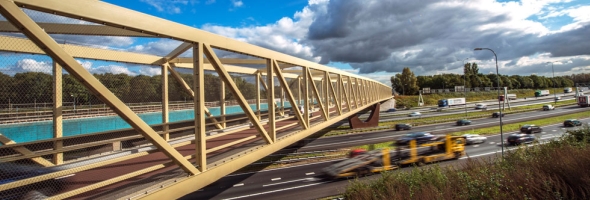Steel has high compressive and tensile strength, and higher elasticity than concrete. However, many steel bridges built in the 1950s and 1960s are now in need of replacement or renovation, as their structural safety does not meet today’s standards. We at Movares have extensive experience in the detailed re-calculation of bridges and the designing of new bridges.
Many steel bridges were designed and built in the Netherlands after World War II. They are now of a substantial age and were designed for static and fatigue loading less severe than they actually encounter over their lifetime. In many cases, it has to be demonstrated that the bridge is fit for future use, meaning that upgrading may be necessary. These bridges are now being reassessed, but it is important not to be over-conservative in these assessments, to avoid unnecessary strengthening.
The paper – “Repair, Strengthening and Upgrading of Steel Bridges in the Netherlands” (presented at the 39th IABSE Symposium, Vancouver, 2017) – gives practical examples of repair, strengthening and upgrading techniques for steel bridges.
Fibre-reinforced plastic (FRP) bridges are relatively new. This material also displays high compressive and tensile strength, but is significantly lighter than steel and/or concrete. Movares designed the world’s first steel/FRP bridge, the hybrid viaduct over the A27 motorway.
Major maintenance work on structures along the Amsterdam-Rhine Canal
The Amsterdam-Rhine Canal forms an important link between the Port of Amsterdam and the Ruhrgebiet industrial area in Germany. This makes it one of the most heavily-used canals in the world.
Eight steel arch bridges along the canal were in need of renovation or replacement. Movares was involved in the project from start to finish.
Read more about major maintenance of bridges along the Amsterdam-Rhine Canal
Extending service life
Contractor KWS-Mercon asked Movares to provide advice regarding the renovation/replacement of these arch bridges. It was possible to renovate three of them, extending their service lives by 30 years. The other five bridges had to be completely replaced. Movares produced the architectural and structural designs, carried out the calculations and provided advice during construction. Right from when the first design sketches were produced, Movares was involved in the aesthetic design and the integration of the structures into their surroundings. Following that phase, the complete structural design was produced. Movares also provided all engineering services in connection with the transportation and installation phase.
Structural design
Structural design involves determining all the dimensions of the load-bearing components. Careful attention is paid to the dimensions of the arch in relation to those of the main girder and to avoiding fatigue problems in the orthotropic deck due to freight traffic.
Cultural considerations
As manager of the canal and the bridges, Rijkswaterstaat (the Directorate-General of Public Works and Water Management) put the project out to tender under the acronym KARGO, which in Dutch stands for “Kunstwerken Amsterdam-Rijnkanaal Groot Onderhoud” (major maintenance of structures on the Amsterdam-Rhine Canal). The cultural importance of the Amsterdam-Rhine Canal is inseparably linked to the series of bridges that cross it. For Rijkswaterstaat, preserving the cultural element was an important element of KARGO, and Movares’ architectural department were involved in ensuring that such considerations were taken on board.
The following videos illustrate various aspects of the project:
Part of the arch was separated from the deck and transported separately. The bridge was reassembled at a staging site and temporary stabilizing components were fitted. It was then floated into position in one piece.
One of the bridges that had to be replaced completely was the Weesper Bridge. The old bridge had to be removed and the new one installed in just eight hours. Transporting the bridge was also a problem in as densely populated a country as the Netherlands.
Read more about the assembly and replacement of the Weesper Bridge
Arch bridges along the Theemsweg Route: the gateway to the Port of Rotterdam
Rotterdam is one of the biggest ports in the world. Rail and shipping traffic to and from the port via the Maasvlakte and Europoort are on the increase. Currently, all that traffic has to pass over or under the Caland Bridge. But this steel lift bridge is not capable of handling the increased traffic, so it is to be replaced by a new railway viaduct – the Theemsweg Route. The new viaduct will ensure that trains can run smoothly. It will also reduce noise.
The new railway viaduct includes two arch bridges, designed by Movares. Building the Theemsweg Route is a challenge; changes will be needed to roads and railway tracks, and to cable and pipework channels. The combination of new-build, interfaces with a variety of specialisms and steel structures requires comprehensive know-how. Which Movares has. The new route will enter service in 2020.
The existing Caland Bridge in the Port of Rotterdam is part of the Havenspoorlijn, the port railway line. The new Theemsweg Route consists of two new arch bridges and a 4-kilometre simply-supported concrete beam structure. The paper entitled “The design of two large span arch bridges in the Port of Rotterdam” (which was presented at the 40th IABSE Symposium, Nantes, 2018) describes the design of the two arch bridges, one with a single span of 172.8 m and the other with a continuous beam over four supports with a total length of 269.1 m.
Read more about the Theemsweg Route in the Port of Rotterdam
Recalculating the A27 motorway
The A27 – one of the most important routes in the Netherlands – is to undergo widening. The plans cover 47 km of motorway, three interchanges and four major river crossings. The structural safety of three steel road bridges no longer meets current standards. The client – the Directorate-General of Public Works and Water Management – wishes to retain the bridges, but in a condition that ensures their safety and extends their service life by 30 years. Movares was commissioned to make a detailed assessment of these steel bridges. [Read more about major maintenance of bridges along the Amsterdam-Rhine Canal]
Detailed recalculations
The standards in force when the bridges were built differ from current standards for new bridges in many respects. Under today’s standards, older bridges would be condemned, even though many of their components are still serviceable. Movares therefore carries out detailed recalculations, which involves detailed modelling. We look closely at the projected loading to which the bridge will be subjected over the coming 30 years, using scientific studies that enable us to make assessments that go beyond the standards. As a result, it is often possible to reinforce certain components rather than replace an entire bridge.
Scientific studies
Movares works with Eindhoven University of Technology to recalculate the bridges in detail. On the basis of scientific study, we were able to work with our client (the Directorate-General of Public Works and Water Management/TNO, the Netherlands organization for applied scientific research) to optimize various aspects of the assessment methodology. Rijkswaterstaat, the Directorate-General for Public Works and Water Management is part of the Dutch Ministry of Infrastructure and Water Management of the Netherlands.
TNO is an independent research organization that focuses on nine social themes:
- Buildings, infrastructure & maritime
- The circular economy and the environment Defence, safety and security
- Energy
- Healthy living
- Industry
- Information & communication technology
- Strategic analysis & policy and traffic
- Transport
Some bridges did not conform to the current Eurocode for new construction. Some steel bridges were showing signs of fatigue damage. Movares made complete recalculations for these bridges, to identify the measures necessary to reinforce them.
Read more about the Merwede Bridge over the Upper Merwede river
Movares designs the world’s first steel/fibre-reinforced plastic bridge
The foundation options for the hybrid viaduct over the busy A27 motorway were limited, and there was a requirement to minimize traffic disruption during the work. Because of the particular conditions that applied, the 140-metre, centre-supported structure was designed with a steel lattice structure and a lightweight deck of fibre-reinforced plastic (FRP). This bridge is a unique combination of FRP and steel.
There were already a railway bridge and a road bridge between the Rijnsweerd and Lunetten junctions on the A27 motorway near Utrecht, and the road bridge had originally been designed to carry a railway line. That road bridge formed part of the main cycle route between the city of Utrecht and the suburb of Houten, and served as an access road in both directions. To accommodate the new Randstadspoor light rail network, which involves doubling the number of tracks, the road bridge has now been converted into the railway bridge it was originally intended to be. The new hybrid viaduct will carry cyclists and local traffic.

Connecting the FRP deck to the lattice girders was challenging, as was the location of the bridge – its foundations were sited on land reclaimed from the sea, with highly compressible soil.
Read more about the steel/fibre-reinforced plastic bridge over the A27 motorway


